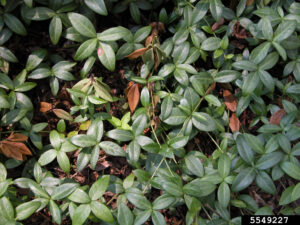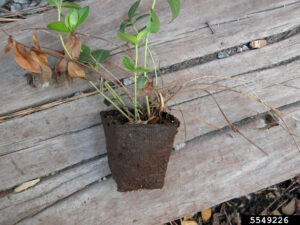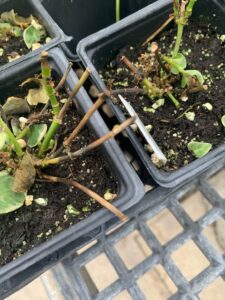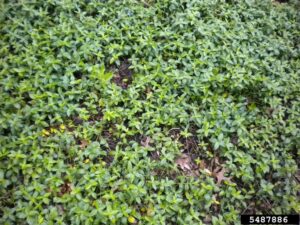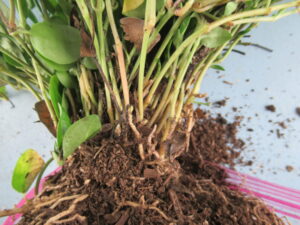
Figure 1. Individual stems infected by Boeremia exigua and dying back. Photo credit PPDL
Periwinkle (Vinca minor) has a few disease issues that can cause severe damage to Vinca in cool wet weather, including Rhizoctonia stem and crown rot, Phytophthora root and crown rot, and Phoma stem blight. The last disease, Phoma stem blight, can cause severe damage to Vinca early in Spring when new stem growth emerges (Fig 1). The pathogen, Boeremia exigua (synonym Phoma exigua), is a fungus that survives in overwintered plant material in the soil for a very long time (multiple years) and can infect vinca when stems touch the soil. Pathogen survival and disease development are favored by cool wet weather (Temperatures between 50 and 65°F) which is why symptoms are often seen in April and May before the Summer’s heat kicks in, but new stem infections can develop in June through August if moisture is present.
Vinca is a perennial vine ground cover and when Phoma stem blight is present it can be found on infected runners below the canopy cover so it may easily escape notice at first (Fig 2). Initial symptoms begin as small dark brown to black lesions on the stem or foliage and will rapidly expand in conducive conditions. Stems are quickly girdled by lesions given their small size which will kill the rest of the plant beyond where it occurs (Figure 3, 4). This is what makes the disease so troublesome. When new stems grow and touch the soil, a new lesion will form and can kill the whole plant (Figure 5). Due to how quickly the disease can progress, a planting can have significant blighting leading to very large dead patches. Given how long the fungus can survive in host tissue within the soil, remediating the area or replanting Vinca is not possible and will lead to death of newly installed plants.
- Figure 2. Dead leaves and wilting plants due to Phoma stem blight infections. Photo credit: Penn State Department of Plant Pathology & Environmental Microbiology Archives, Penn State University, Bugwood.org
- Figure 3. Stem dieback of a potted Vinca due to Phoma stem blight. Photo Credit: Penn State Department of Plant Pathology & Environmental Microbiology Archives, Penn State University, Bugwood.org
- Figure 4: Declining Vinca plant due to Pythium root rot and Phoma stem blight. Credit: PPDL
- Figure 5: Bare patches in a Vinca planting cased by Phoma stem blight. Credit: Elizabeth Bush, Virginia Polytechnic Institute and State University, Bugwood.org
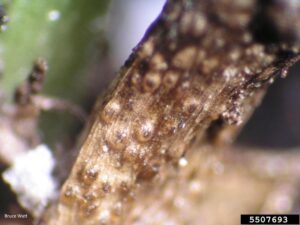
Figure 6: Pycnidia of Boeremia exigua, developing on the stem of a dead Vinca stem.
Credit: Bruce Watt, University of Maine, Bugwood.org
The pathogen has fungal fruiting bodies call pycnidia which produce spores that are moved by water splash which can lead to local infections, but infected plant material is the primary cause for infections in new locations (Figure 6). When purchasing Vinca, it is important to only pick healthy plants with vigorous growth. The pathogen thrives in wet conditions so water only enough to keep plants healthy during dry periods and avoid wetting the foliage where possible. Improve air circulation within the canopy by thinning and spacing out plants. Remove as much of the old, dead leaves and stems as possible to reduce the amount of potential inoculum for the next season. Work with plants when they are dry to avoid spreading the fungus since spores are sticky and are produced and easily moved when conditions are humid.
